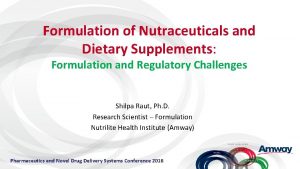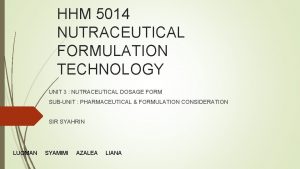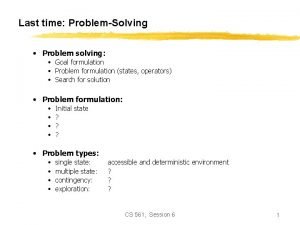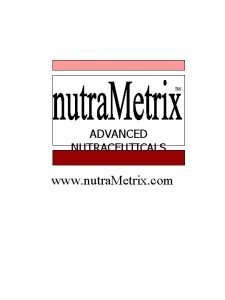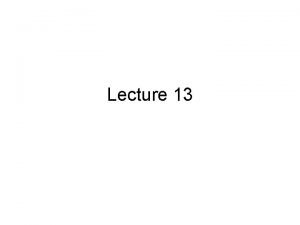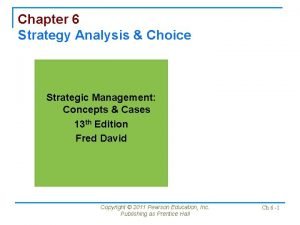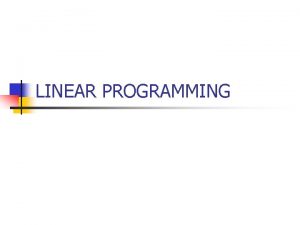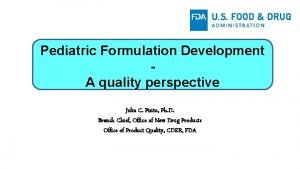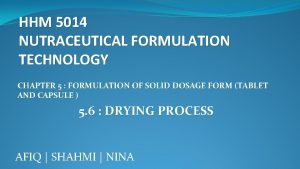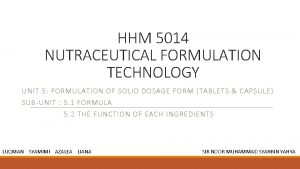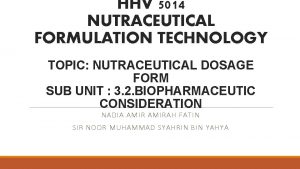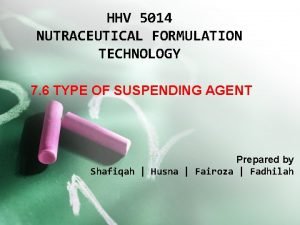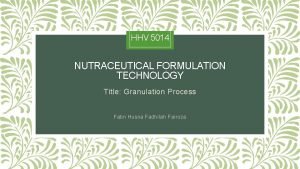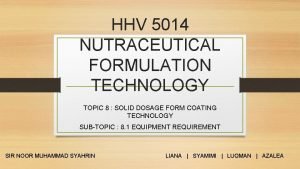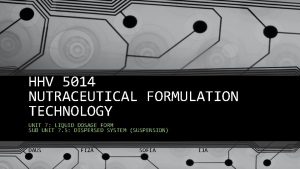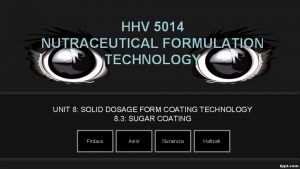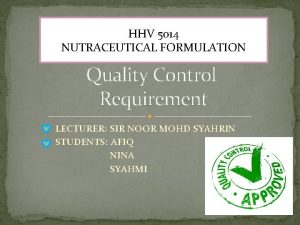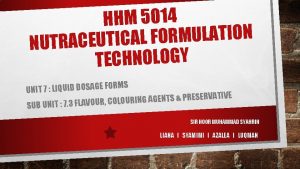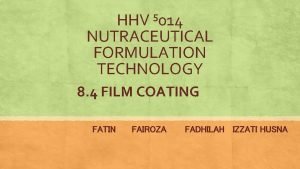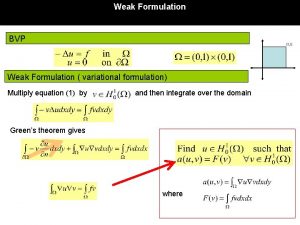HHM 5014 NUTRACEUTICAL FORMULATION TECHNOLOGY CHARTER 7 7
















- Slides: 16

HHM 5014 NUTRACEUTICAL FORMULATION TECHNOLOGY CHARTER 7. 7 : INTERNAL & EXTERNAL DOSAGE FORM & PRESERVATIVES AFIQ | SHAHMI | NINA

DOSAGE FORM “Dose form is defined as products designed for suitable administration of a drug to a patient for diagnosis , prevention and treatment of a disease or relief of symptoms”

Need Of Various Dosage Forms 1. To mask the bitter taste or foul odor of the drug. E. g. capsules, syrup. 2. For protection of drug from destruction by gastric juices on oral administration. E. g. enteric coated tablets. 3. To provide optimal drug action of topical application. E. g. ointments, cream. 4. To provide for placement of drug within the body tissue. E. g. injections.

Drug Forms For External Use • Different preparations are available such as solid preparation, semisolid and liquid preparations. • E. g. 1. Powders 2. Ointments 3. Creams 4. Lotions 5. Liniments 6. Plasters 7. Pessaries 8. Suppository.

Drug Forms For Internal Use For oral administration: • Solid : 1. TABLETS 2. CAPSULES 3. POWDER 4. GRANULES • Liquid : Solution Mixture Suspension Emulsion

• SUSPENSION Suspension is a liquid medicament containing insoluble solids which are uniformly distributed through out the body of vehicle with or without the help of suspending agents. ” • EMULSION “An emulsion may be defined as a system of two immiscible liquid phases, one of which is reduced to a fine state of subdivisions (fine globules) and uniformly distributed through out the other by means of third inert agent called emulsifying agent. ” • SOLUTION Solution is a perfectly homogenous liquid preparation containing one or more substances dissolved in fluid medium. ”

Liquid Dosage Forms

PRESERVATIVES A preservative is a natural or synthetic chemical that is added to products such as foods, pharmaceuticals, paints, biological samples, wood, etc. to prevent decomposition by microbial growth or by undesirable chemical changes.

Ideal Properties of Preservatives 1. It should not be irritant. 2. It should not be toxic. 3. It should be physically and chemically stable. 4. Preservative should be compatible with other ingredients used in formulation. 5. It should be act as good antimicrobial agent and should exert wide spectrum of activity. 6. It should act as preservative in small concentration i. e. it must be potent. 7. It should maintain activity throughout product manufacturing, shelf life and usage

Classification Of Preservatives A. Classification Based On Mechanism Of Action B. Classification Based On Source

A. Classification Based On Mechanism Of Action 1. Antioxidants: The agent which prevent oxidation of Active pharmaceutical ingredient which otherwise undergo degradation due to oxidation as they are sensitive to oxygen. Eg. Vitamin E, Vitamin C, Butylatedhydroxyanisole ( BHA), Butylatedhydroxytoluene (BHT).

2. Antimicrobial agents: The agent which active against gram positive & gram negative microorganism which causes degradation of pharmaceutical preparation which are active in small inclusion level. Eg. Benzoates, Sodium benzoate, Sorbates 3. Chelating agents: The agents which form the complex with pharmaceutical ingredient and prevent the degradation of pharmaceutical formulation. Eg. Disodium ethylenediamine tetraacetic acid (EDTA), Polyphosphates, Citric acid

B. Classification Based On Source 1. Natural Preservatives: These drugs are obtained by natural sources that are plant, mineral sources, animal etc. Eg. Neem Oil, Salt (sodium chloride), Lemon, Honey 2. Artificial Preservatives: These preservative are man made by chemical synthesis active against by various micro-organisms in small concentration. Eg. Benzoates, Sodium benzoate, Sorbates, propionets, nitrites.

Preservative concentrations recommended for parental preparation

Preservative Concentration for Liquid Oral Preparation

 Nutraceutical formulation development
Nutraceutical formulation development Nutraceutical formulation
Nutraceutical formulation Why problem formulation follow goal formulation
Why problem formulation follow goal formulation Difference between voyage charter and time charter
Difference between voyage charter and time charter Advanced nutraceuticals
Advanced nutraceuticals Longest common subset
Longest common subset Monophasic liquid form
Monophasic liquid form Research problem formulation
Research problem formulation Project formulation and evaluation
Project formulation and evaluation Project formulation example
Project formulation example Question formulation technique worksheet
Question formulation technique worksheet Role of hrm in strategy formulation
Role of hrm in strategy formulation Matching stage of strategy formulation framework
Matching stage of strategy formulation framework Advantages of linear programming
Advantages of linear programming Pancrealipase
Pancrealipase Types of functional strategy
Types of functional strategy Arc consistency sudoku
Arc consistency sudoku
